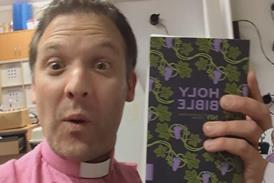After St Mark’s Church in Southend decided to host a drag queen performance for children, Caroline Farrow says gender theory indoctrination has gone too far

Over the past few years, the label ‘troll’, which was once used to describe a community disruptor or someone who derives enjoyment from whipping up hostility, drama and conflict online, has been liberally applied to anyone who dares to express an opinion contrary to the accepted status quo.
Thus it was an article appeared in the Basildon and Southend Echo, complaining about the “trolls” who had “viciously targeted” St Mark’s CofE church in Southend after they posted photographs online of children sat in the pews, “enjoying an age-appropriate drag queen event”.
Anyone outraged by the oxymoronic notion that a drag queen is age-appropriate entertainment for children and/or that a place of worship is a fitting venue to hold such an event, is, according to our intrepid online reporter, a bad-faith “conspiracy theorist”.
Innocent comedy or indoctrination?
Promoters of drag like to claim that it is nothing more than the practice of men dressing up as women for the purposes of entertainment, harking back to the traditions of pantomime dames or popular entertainers such as Les Dawson.
If we were to play devil’s advocate and accept that argument, it still does not explain the constant drive to ensure that children are exposed to drag performances under the aegis of tolerance.
If drag is nothing more than an innocent form of comedy, why are LGBT lobby groups and activists so keen to promote and introduce it to children? And moreover, why is it thought appropriate to turn a church into a secular playhouse for the purposes of public entertainment?
The truth is that unlike the family entertainers who featured in the childhoods of Generations X and Y, the type of drag being promoted into the mainstream by actors such as RuPaul consists of highly sexualised performances originally found in gay nightclubs. While men have always dressed up to perform female roles, such as in Shakespeare’s time, this was out of necessity and driven by patriarchal and misogynistic norms that forbade women from making an ‘ungodly spectacle’ of themselves on the stage.
Parents could allow children to watch entertainers such as Danny La Rue or Hinge and Bracket who were screened before the watershed, because the joke was that these performers were clearly men. Kenny Everett did not even bother to shave off his beard, whereas nowadays Everett would be cancelled as transphobic, unless of course, he had come out as non-binary or transgender, as opposed to being just an extraordinarily funny and zany gay man.
Even though my parents allowed me to watch the Kenny Everett show, they would have been the first to complain had the school decided to dedicate valuable curriculum time to nurturing an appreciation of his work. The idea of a priest or vicar inviting him into the church to cavort around would have been unthinkable.
Drag queens are presented as the respectable and joyful front of an agenda that seeks to introduce adult concepts of sex and sexuality to children
The truth is that drag acts are being introduced into schools and liberal church communities, because they are an easy way for these institutions to virtue signal their respect for sexual minorities and be seen to be fostering the values of diversity and tolerance. Drag queens are the way of nailing one’s rainbow colours to the mast in the bitter culture wars, of showing that you are on the right side of history, with children as the collateral damage.
Drag is offensive because it attempts to pass itself off as a highly-sexualised caricature of femininity. It is as amusing to women as the minstrel shows were to the black community. Many of the performers wear tight fitting, revealing and sexually provocative outfits and introduce themselves with names containing explicit sexual innuendo, such as Flo-Job.
Controversial drag queen Aida H Dee, for example, wears a costume in which the outline of their genitals is clearly visible, and often posts sexually explicit material to social media. If a teacher or religious leader were seen to be posting similar, they would be immediately suspended pending investigation.
Drag queens are presented to children as part of efforts to indoctrinate them with gender theory and the idea that gender is a social construct, as opposed to the biological reality that sex is immutable. The children know that the drag queens are really men, but are being forced to accept that they could be women because of how they are dressed.
Drag queens are presented as the respectable and joyful front of an agenda that seeks to introduce adult concepts of sex and sexuality to children and coerce them into transgressing their natural boundaries. Many of the children pictured in drag queen events appear to be uncomfortable.
Blasphemy
One has to ask why just the chosen stage name of the drag queen who appeared at St Marks – Kenzie Blackheart (real name Matt Hunt) – did not cause the vicar of St Mark’s to ask herself whether or not this performer or performance was going to reflect Christian values.
Irrespective of whether or not the performance contained any sexual innuendo, the photos show a man dressed in a tight-fitting all-in-one corset and tights, in front of an altar bedecked with political LGBT messaging such as “born this gay” and “trans pride”. It is true that we are called to love and to serve LGBT people, but we do so in service of the Lord and not at his expense.
It is no wonder that this image provoked such widespread anger and outrage as it was nothing short of sacrilege and blasphemy, constituting desecration of a holy place and demonstrating a disrespect for God’s teachings in one of the holiest of places.
What happened at St Mark’s was on a par with the moneychangers in the temple and we all know what Jesus did when confronted with them. But then again, had the internet been around in those days, Jesus would have been painted by the Romans as a vicious angry troll, too.







































1 Reader's comment